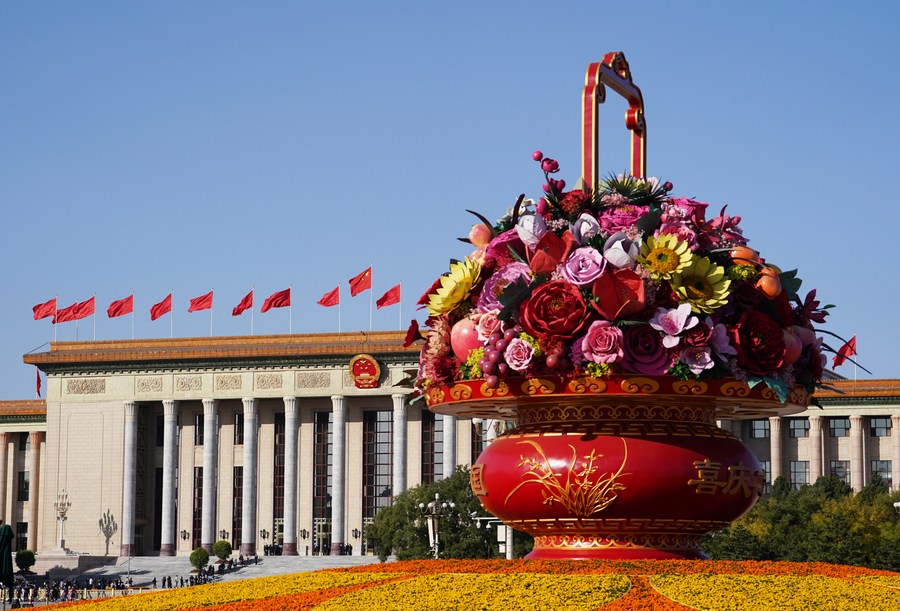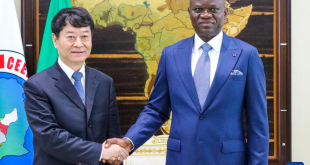Publishe : January 03,2023
By XU WEI

This photo taken on Oct 16, 2022 shows the Great Hall of the People in Beijing, the capital of China. [Photo/Xinhua]
Vision ensures common prosperity for all, pursues peaceful development
China’s broader push for its pathway to modernization has fueled expectations that the nation will bring more opportunities and create a dynamic of growth that will deliver wide-ranging benefits for the world, according to business leaders and analysts.
The Chinese path to modernization, a key vision outlined by Xi Jinping, general secretary of the Communist Party of China Central Committee, in his report to the 20th CPC National Congress, is the modernization of a huge population, and it ensures common prosperity for all and pursues peaceful development.
This path will also entail the promotion of high-standard opening-up, including the high-quality development of the Belt and Road Initiative and broader steps to share its development experience, analysts said.
Raymund Chao, chairman of PwC Asia-Pacific and China, said the vision of the Chinese path to modernization was proposed at a pivotal moment with the international environment becoming increasingly complex and uncertain and global leaders contemplating solutions to the challenges brought about by the COVID-19 pandemic, regional conflicts, and supply chain and trade disruptions.
“The path to ‘Chinese modernization’ and developing China as a ‘great modern socialist country’ by the mid-21st century will have profound implications for economic and social development, both for the world and China, in the coming years,” he said.
To follow this path and attain this goal, he said the nation will expand institutional opening-up with regard to rules, regulations, management and standards, promote high-quality development of the BRI and endeavor to preserve the diversity and stability of the international economic landscape and trade relations.
China’s top leadership reaffirmed its push for the Chinese path to modernization at the annual tone-setting Central Economic Work Conference in December, during which policymakers pledged to make greater efforts to attract more foreign capital, widen market access and further open up the modern services sector.
They also highlighted the nation’s unwavering commitment to join high-standard economic and trade agreements, including the Comprehensive and Progressive Agreement for Trans-Pacific Partnership and the Digital Economy Partnership Agreement.
Xi said in a written speech delivered at the APEC CEO Summit in Bangkok in November that no more than 30 countries, with a total population of less than 1 billion, have achieved industrialization so far. He said that China’s middle-income population will increase to over 800 million in the next 15 years, and promote the sustained growth of China’s supersized market.
Chao said the modernization of China’s 1.4 billion population to promote common prosperity will unleash consumer demand for high-quality goods and services as the nation pushes for the building of a community with a shared future for mankind.
“A modernized China will bring more opportunities and create a dynamic of growth for both the region and the world,” he said. “It is also a strong signal of China further opening up to the world, underscoring the country’s commitment to pursue an open strategy of achieving peaceful and coordinated development for win-win outcomes.”
Ivona Ladjevac, deputy director of Serbia’s Institute of International Politics and Economics, said China’s modernization is inextricably linked with socialist modernization, which contains unique elements making it unlike modernization pursued by any other countries.
“Not for a moment rejecting the fact that it is a long-term process, it was started with the desire that the end result would be a prosperous society based on equity and justice, a society that would not be polarized,” she said.
Ladjevac said that China’s vision for its modernization has been encouraging to other developing countries.
“A commitment to peace, development, cooperation and mutual benefit, along with a firm determination to preserve world peace and development, underlies China’s modernization,” she said.
“Through its realization, China makes a greater contribution to peace and development in the world,” she added.
As part of its broader push to promote global development, China decided last year to upgrade its South-South Cooperation Assistance Fund to a Global Development and South-South Cooperation Fund and add $1 billion to the fund on top of the $3 billion already committed.
In a speech on China’s diplomacy delivered on Dec 25, Wang Yi, who was then foreign minister and is now director of the Office of the Foreign Affairs Commission of the CPC Central Committee, said Beijing will stay committed to a Chinese path to modernization, not only creating a new form of human advancement, but also providing new choices for developing countries.
“We will firmly support developing countries in exploring development paths suited to their national conditions and embarking on a fast track toward modernization at an early date,” he said.
Chea Munyrith, president of the Cambodian Chinese Evolution Researcher Association, said he believes the Chinese path to modernization will entail furthering sharing of China’s expertise in development, including for global poverty reduction and the easing of the global food crisis.
For example, he said that Chinese experts are working with their counterparts from Cambodia on devising a master plan for the development of modern agriculture in his country.
As part of the plan, experts sent by the Foreign Economic Cooperation Center of the Chinese Ministry of Agriculture and Rural Affairs will help the Southeast Asian nation build up its expertise in growth of milled rice, corn, rubber, cassava, bananas, animal production and aquaculture and work toward better food security.
“This is another vivid example that China, after its success in attaining rural development, is sharing its outcomes from development through win-win cooperation with developing economies,” he said.
The Cambodian scholar also underscored the significance of China’s commitment to free trade and sharing its large domestic market with the world, especially developing countries, which will offer strong impetus to the global economic recovery.
Andy Mok, a senior research fellow at the Center for China and Globalization, a Beijing-based think tank, said China’s development is especially important for developing countries because it also provides a successful model that is based on actual experience and “not erroneous beliefs and self-serving ideologies that have led some nations astray”.
“By adhering to a path of peaceful development, China can play a positive role in avoiding or minimizing future conflicts,” he said.
He added that making greater strides in opening up is an inevitable choice for China’s future modernization efforts as opening-up provides domestic benefits for China by giving consumers a wider array of products and services while fostering a more competitive economy that leads to greater efficiency.
“China’s opening-up provides market and investment opportunities for all types of businesses around the world, ranging from Fortune 500 to small and medium-sized enterprises,” he said.
China Daily
 Africa -China Review Africa -China Cooperation and Transformation
Africa -China Review Africa -China Cooperation and Transformation
